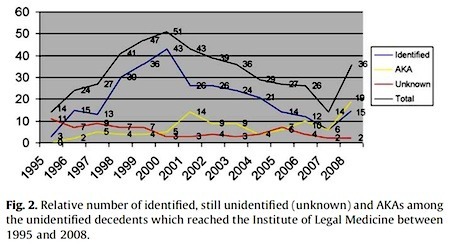Marc Abrahams's Blog, page 495
May 5, 2013
An interesting sentence about an opposite phenomenon
Some things begin with notions of nothing. Here is one such thing:
“Evaluating Replication Results,” Uri Simonsohn, SSRN report # 2259879, epub May 2, 2013. The author, at the University of Pennsylvania, begins the paper with this sentence:
“Most psychology experiments produce intrinsically uninteresting data.”
(Thanks to investigator Rolf Zwaan for bringing this to our attention.)

May 4, 2013
Are creative students a burden to teachers?
Should this monograph create a stir?
“Creativity: Asset or Burden in the Classroom?” Erik L. Westby [pictured here — he is now a teacher at the Russell Byers Charter School] and V.L. Dawson, Creativity Research Journal, 1995, Vol. 8, No. 1, 1-10. The authors, at Union College and Skidmore College, began with this pronouncement:
“One of the most consistent findings in educational studies of creativity has been that teachers dislilce personality traits associated with creativity. Research has indicated that teachers pref er traits that seem to run counter to creativity, such as conformity and unquestioning acceptanee of authority.”

May 3, 2013
For specialists: Comment on stats re Plackett family of copulas
Most specialists in most fields seldom comment on anything to do with the Plackett family of copulas. Here is an exception:
“Comment on ‘Trivariate statistical analysis of extreme rainfall events via the Plackett family of copulas’ by Shih-Chieh Kao and Rao S. Govindaraju: How are trivariate copulas put to use?“, T.P. Hutchinson, Water Resources Research, vol. 46, 2010, W04801.
(Thanks to investigator Tom Gill for bringing this to our attention.)
BONUS: Trivariate statistical analysis of extreme rainfall events via the Plackett family of copulas

A quick look at Improbable bits of TEDx CERN
TEDx CERN Facebook page posted a few photos from today’s event. Here are some of the Improbable people, with accompanying text from that Facebook page:
“It’s not usual to have bras thrown into the audience at CERN. Then again, Marc Abrahams is not your usual guy. Marc is the one behind the infamous Ig Nobel Awards and editor of Annals of Improbable Research focuses on research that makes you laugh, then think! You’re never going to look at science research quite the same after his talk.”
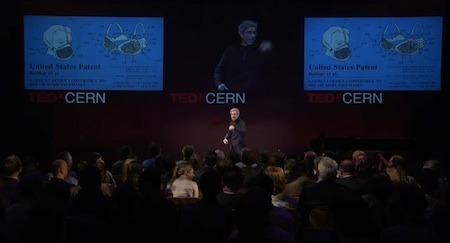 Maria Ferrante singing songs from Ig Nobel operas: ”Some crave coffee that steaming hot! More delightful music from Maria Ferrante!”
Maria Ferrante singing songs from Ig Nobel operas: ”Some crave coffee that steaming hot! More delightful music from Maria Ferrante!”
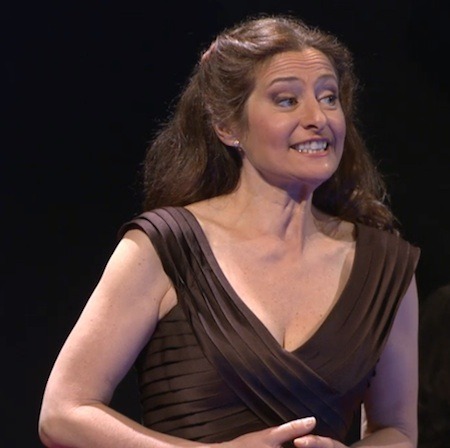
Pianist Alice Martelli accompanies Maria Ferrante:
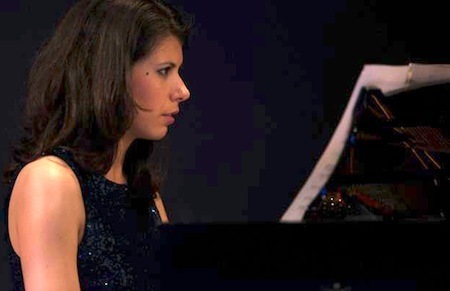
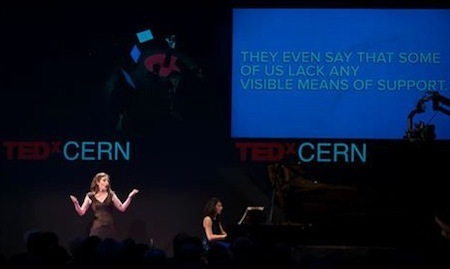
Video will be posted on the TEDx CERN web site.

May 2, 2013
Hot potatoes to combat nuclear Armageddon
“Each message is regarded as a ‘hot potato’, and the nodes are not wearing gloves. Rather than hold the ‘hot potato’ the node tosses the message to its neighbor, who will now try to get rid of the message.”
 The paragraph above is describing aspects of the Hot Potato Algorithm, originally developed by (the late) Paul Baran at the RAND Corporation, 1962, and described in his paper : ‘On Distributed Communications Networks.’ The paper outlined the problems facing designers of digital communication networks who are faced with using links of “less than perfect reliability.” Very much less-than-perfect, in fact. The author takes as an example a system in which :
The paragraph above is describing aspects of the Hot Potato Algorithm, originally developed by (the late) Paul Baran at the RAND Corporation, 1962, and described in his paper : ‘On Distributed Communications Networks.’ The paper outlined the problems facing designers of digital communication networks who are faced with using links of “less than perfect reliability.” Very much less-than-perfect, in fact. The author takes as an example a system in which :
“…the form of the disturbance or noise is the simultaneous destruction of many geographically separated installations.”
[Think: recently vaporised in a full-scale nuclear war] The Hot Potato Algorithm, and its associated Hot Potato Routing techniques attempt to construct a “Way of providing survivability of complex networks in the Nuclear Age.” For other potato-based variants which grew from Paul Baran’s research, see:
 Randomized greedy hot potato routing
Randomized greedy hot potato routing
 Cold potato routing (as compared to Hot) and
Cold potato routing (as compared to Hot) and
 Mashed potato routing (Note: possibly less than 100% serious… note publication date, and author)
Mashed potato routing (Note: possibly less than 100% serious… note publication date, and author)

TED on TEDx, with Searle, Smoot, and Ig Nobel Thoughts
The TED blog previews tomorrow’s TEDx CERN talks. The preview begins:
6 reasons to watch TEDxCERN this FridayYou have probably heard of CERN — the European Organization for Nuclear Research and the home of the Large Hadron Collider (LHC), the world’s largest and most powerful particle accelerator that is longer than the island of Manhattan. CERN and LHC are famous for their role in the recent discovery of what very likely is the Higgs boson, a particle crucial to the standard model of physics. But now, CERN will house another exciting first: their first TEDx event.
This Friday, May 3, CERN will bring together thinkers of all kinds to examine our universe and provide insight into why studying it matters. And lucky for you, you don’t have to go to Switzerland to watch in real time. The program will stream live online at the TEDxCERN website from 13:45 to 20:00 (CEST).
So why should you tune in?
1. Because of the incredible speaker lineup. CERN has invited 23 great speakers and performers to the stage. Some highlights of the lineup:
Philosopher John Searle, the winner of the 2004 National Humanities Award
Astrophysicist George Smoot, cosmologist and Nobel Prize laureate
Chris Lintott, the head of Zooniverse at Oxford University and co-presenter of the BBC’s Sky at Night program
Marc Abrahams, MC of the Ig Nobel Awards and editor of the Annals of Improbable Research
18-year-old Britney Wegner, grand prize winner of the 2012 Google Science Fair
Sergio Bertolucci, director for research and scientific computing at CERN…
BONUS SECOND EVENT: And if you are or will be in Geneva next week, come to the big Ig Nobel show we’ll do that evening at the University of Geneva on May 7.

Analysis of certain aspects of a falling pomelo
This study of a pomelo falls, somewhat and so to speak, in the tradition of the Ig Nobel Prize-winning study “Injuries Due to Falling Coconuts“:
“Viscoelasticity and compaction behaviour of the foam-like pomelo (Citrus maxima) peel,” Marc Thielen, Thomas Speck, Robin Seidel, Journal of Materials Science, vol. 48, no. 9, May 2013, pp. 3469-3478. The authors, at the University of Freiburg, Germany, report:
“The pomelo (Citrus maxima) is the largest and heaviest fruit of the genus Citrus and can acquire considerable potential energy as it ripens hanging up to 15 m height. Its thick foam-like structured peel presumably acts inter alia as a shock absorbing layer, protecting the fruit as it impacts on the ground upon being shed. Thereby the peel dissipates kinetic energy by being compacted. In order to elucidate the compaction mechanism of the highly heterogeneous pomelo peel, we conducted incremental stress relaxation tests…. [Our analysis] indicates the strong influence of the peel samples’ geometry and composition which is attributed to the fruit shape, a gradual changing density of the peel, which can be considered as a stacked array of foam layers differing in density, and the turgescence of the biological cells.”
Here is detail from the study:
(Thanks to investigator Eugenie Reich for bringing this to our attention.)

April 30, 2013
Towards a LEGO Minifigures® taxonomy
Dr. Christoph Bartneck, at the University of Canterbury HITLab NZ, not only investigates whether robot cats and dogs can be programmed to convincingly display ‘pain’, he also develops taxonomical models for LEGO Minifigures® – of which there are now more than 4000 (and 3600 are listed in his book ‘The Unofficial LEGO Minifigure® Catalog’
He explains some of the rationale behind the new approach here :
“Besides categorizing the figures, we also need to have a nomenclature. The Linnaean taxonomy uses the the [sic] combination of a genus name and a second term. Of course we should not use Latin terms, as proposed by Linnaeus. We could us [sic] acronyms and serial numbers. Here is my proposal:
aaa-bbb-yyyy-sss
where:
aaa stands for the second last level in the taxonomy, for example stw for Star Wars
bbb stands for the last level in the taxonomy, for exampel [sic] ep1 for Episode 1
yyyy stands for the year in which the figure was produced first, for example 2001
sss stands for a three digit serial number with preceedings [sic] zeros, for example 007
The advantage of this nomenclature is that [sic] distinguish between the older figures in the Town theme from the newer figures in the City theme. “
An interactive map of the proposed taxonomy can be explored here

CSI works better on TV than in real life (in Italy)?
On television — especially American television — forensic scientists almost always figure out the identity of mysterious corpses. This study suggests that the actual results — in real life, dealing with real corpses — may not be as good, especially outside America:
“Unidentified bodies and human remains: An Italian glimpse through a European problem,” Cristina Cattaneo, Pasquale Poppa [pictured here], et al., Forensic Science International, vol. 195, no. 1, 2010, pp. 167-e1. The authors, at Università degli Studi di Milano, Italy, report:

Corpse-identification specialist Pasquale Poppa
“The identification of cadavers (the main activity of forensic odontologists and anthropologists) is a crucial issue in forensic pathology, but the official entity of this problem is still poorly known in most countries, apart from a few American reports. In this article the authors present a descriptive study of unidentified decedents over a 14-year period (1995–2008) in Milan. The number of cadavers or human remains arriving at the morgue with no identity amounts to 454 – 3.1% of all autopsies at the Institute of Legal Medicine, with a mean of 32 unidentified subjects every year; 62% reached a positive identification in a period of time ranging from a few days to 10 years. 17% on an average remain unidentified.”
Detail from the study [which also explains "21% are AKAs ("also known as"), whose identification is not certain"]:
(Thanks to investigator Gregory Tallas for bringing this to our attention.)

Improbable Research and Ig Nobel at TEDx CERN
Geneva, Switzerland (and environs) will host lots of Improbability during the next week or so: two events. Both events will be webcast. Soprano Maria Ferrante and pianist Alice Martelli will perform songs from Ig Nobel operas, at both events.
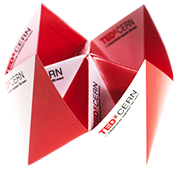 Improbable Research at CERN
Improbable Research at CERNI will do a TEDx CERN talk on the topic: “Why All Good, and Some Bad, Research is Improbable“:
TEDxCERN,
Friday, May 3, 2013, 2:00 pm , Geneva time. [TWITTER: #TEDxCERN]
Webcast starts at 1:45 pm [7:45 am US eastern time].
My talk, and Maria and Alice’s musical performance, will be in the first of TEDx CERN’s three sessions.
 Ig Nobel at the University of Geneva
Ig Nobel at the University of GenevaFour nights later, there’s a big Ig Nobel show at the University of Geneva:
UNIVERSITY OF GENEVA
Tuesday, May 7, 6:30 pm, Geneva time. [TWITTER: #IgNobelGVA]
Uni Dufour, Rue Général-Dufour 24.
Show en anglais, sans interprétation.
Admission is FREE.The University of Geneva show features genuine Ig Nobel Prize winners, who will explain, as best they can, what they did and why they did it:
Stephan Bolliger and Steffen Ross (is it better to be smashed on the head with a full bottle of be, or to be smashed on the head with an empty bottle of beer?)
Bart Knols (malaria mosquitoes are strongly attracted to the smells of Limburger cheese and human feet)
Kees Moeliker (homosexual necrophilia in the mallard duck)

Marc Abrahams's Blog
- Marc Abrahams's profile
- 14 followers


